#the text is the basic gist of it but i have more snippets up my sleeve
Explore tagged Tumblr posts
Text
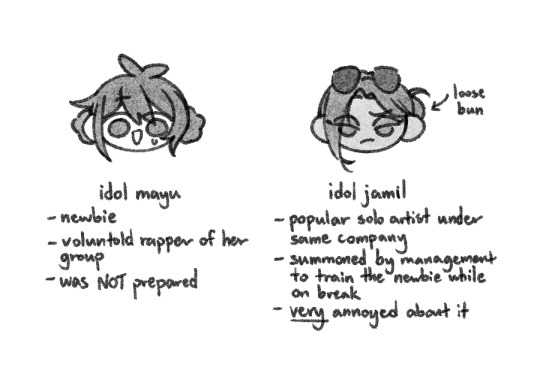


idol au 2.0 jamimayu starts with jamil wondering who is this pathetic wet cat here to waste his time (more AU details under the cut)
Mayu: Member of an up-and-coming fresh new girl group, voluntold to be the rapper because nobody volunteered and management decided to just Pick Someone 💀 (they also refused to let her decline)
Jamil: Solo artist under the same management company. Talented singer, rapper, and dancer. Left home to pursue his career because he wasn’t happy with the life his parents had planned for him. Refused to join any group because he either makes it on his own, or not at all. Writes & produces his own songs and is extremely perfectionistic. Later on has help assigned to him by management, but is known to be difficult to work with because of his strict standards. On a bit of a break right now.
Has a Vil-Neige like situation with Kalim, who is also from the same company but more popular and well-liked despite being less skilled than him and Jamil hates it. (Also because Kalim’s kind of a nepo baby that the company often allocates more resources to.)
Overall premise
Mayu gets voluntold to be the rapper but, unfortunately, has very little experience and urgently needs to be trained before her group releases more music.
Management calls on Jamil to assign him as Mayu’s mentor (to humble him), which he very much declines immediately, but some way or another they pressure him into doing it. Probably holds something in his contract over his head. To say he's displeased would be an understatement.
Not the best impression of each other at their first meeting. Mayu very awkwardly politely bows to her senpai while Jamil lifts his sunglasses to stare/half glare at her before responding, thinking she looks like such a pathetic wet cat. Mayu thinks this guy absolutely hates that he needs to help her (she would be correct). Management refuses to pick someone else for the job so they're essentially stuck together.
Jamil deliberately puts her through Merciless Training From Hell as an attempt to pressure her so hard that she asks for someone else or gives up, because he genuinely didn't want this job, he has other better stuff to do.
Somehow, however, she manages to keep up with his demands and does all the assigned homework, and is overall very diligent and hardworking. She's trying so hard under the assumption that he’s being tough on her for her own sake, but in reality he uh... literally just hates “babysitting duty" 💀
After a while he feels kinda guilty about it. And maybe a teensy bit impressed that she’s been keeping up with demands. (And later unfortunately just a bit proud to watch her improve under his instruction). But he’s too prideful to back down now so he just… keeps doing the same thing.
Mayu has like a mini sulking episode at some point bc she thinks it’s her problem that she's slow and can't do everything he asks and he’s like 🧍♂️
He ends up making her something as like "reward for the hard work" (bro feels bad but can't admit it) and she sniffles and says “This is surprisingly good, I didn’t know you could cook” to which he responds "What, you thought I had no life skills just because I’m an idol?"
The mentorship continues, but interspersed between training sessions are more moments where he’s actually… kinda nice to her and gives encouraging feedback, and also some treats here and there. It’s actually kind of nice to work with each other now. Jamil Viper, have you gotten soft 🤨
#my art#twisted wonderland#twst#jamil viper#oc#twst oc#shiokawa mayu#jamimayu#idol au#the text is the basic gist of it but i have more snippets up my sleeve#more doodle ideas for this au in the notes/drafts so#pray i have the will to get to them 😭#this AU is hardmode for jamil bc every time hes nice shes like#am i in trouble whats going on#also im not into alnst but someone told me my idol jamil design looks very hyuna#what a coincidence...
564 notes
·
View notes
Text
the actual ttrpg book is Directive on Superpowers: A Guide to Metahuman Powers in the DC Universe for the DC Universe RPG, which is formatted to kinda look like an actual government document with little snippets/memos from DEO agents' reports scattered throughout, some of which are from "operative 4182," who's only really vaguely hal-related in the book itself
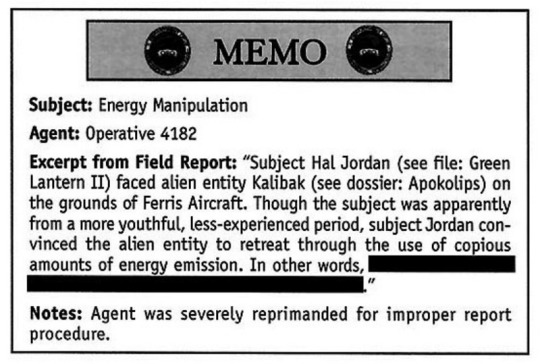

(there's a couple more, but they're long, and you get the gist)
however!! there was also a website that goes along with it (made by one of the writers) that's set up to look like a leak of all the "classified" information that was redacted in the actual book, and the "uncensored" memos lay it on way thicker




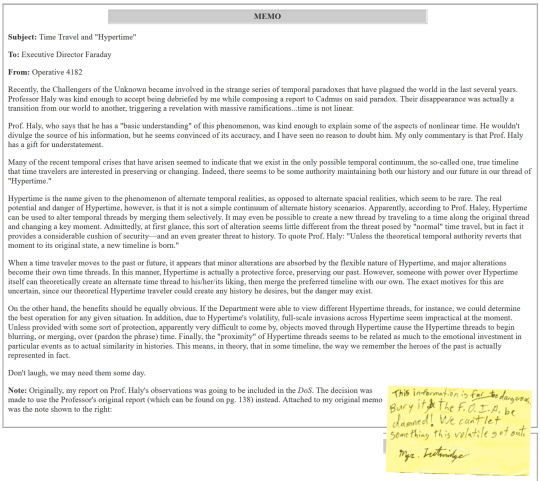
this one is too big for alt text so:
MEMO Subject: Time Travel and "Hypertime" To: Executive Director Faraday From: Operative 4182 Recently, the Challengers of the Unknown became involved in the strange series of temporal paradoxes that have plagued the world in the last several years. Professor Haly was kind enough to accept being debriefed by me while composing a report to Cadmus on said paradox. Their disappearance was actually a transition from our world to another, triggering a revelation with massive ramifications...time is not linear. Prof. Haly, who says that he has a "basic understanding" of this phenomenon, was kind enough to explain some of the aspects of nonlinear time. He wouldn't divulge the source of his information, but he seems convinced of its accuracy, and I have seen no reason to doubt him. My only commentary is that Prof. Haly has a gift for understatement. Many of the recent temporal crises that have arisen seemed to indicate that we exist in the only possible temporal continuum, the so-called one, true timeline that time travelers are interested in preserving or changing. Indeed, there seems to be some authority maintaining both our history and our future in our thread of "Hypertime." Hypertime is the name given to the phenomenon of alternate temporal realities, as opposed to alternate spacial realities, which seem to be rare. The real potential and danger of Hypertime, however, is that it is not a simple continuum of alternate history scenarios. Apparently, according to Prof. Haley, Hypertime can be used to alter temporal threads by merging them selectively. It may even be possible to create a new thread by traveling to a time along the original thread and changing a key moment. Admittedly, at first glance, this sort of alteration seems little different from the threat posed by "normal" time travel, but in fact it provides a considerable cushion of security—and an even greater threat to history. To quote Prof. Haly: "Unless the theoretical temporal authority reverts that moment to its original state, a new timeline is born." When a time traveler moves to the past or future, it appears that minor alterations are absorbed by the flexible nature of Hypertime, and major alterations become their own time threads. In this manner, Hypertime is actually a protective force, preserving our past. However, someone with power over Hypertime itself can theoretically create an alternate time thread to his/her/its liking, then merge the preferred timeline with our own. The exact motives for this are uncertain, since our theoretical Hypertime traveler could create any history he desires, but the danger may exist. On the other hand, the benefits should be equally obvious. If the Department were able to view different Hypertime threads, for instance, we could determine the best operation for any given situation. In addition, due to Hypertime's volatility, full-scale invasions across Hypertime seem impractical at the moment. Unless provided with some sort of protection, apparently very difficult to come by, objects moved through Hypertime cause the Hypertime threads to begin blurring, or merging, over (pardon the phrase) time. Finally, the "proximity" of Hypertime threads seems to be related as much to the emotional investment in particular events as to actual similarity in histories. This means, in theory, that in some timeline, the way we remember the heroes of the past is actually represented in fact. Don't laugh, we may need them some day. Note: Originally, my report on Prof. Haly's observations was going to be included in the DoS. The decision was made to use the Professor's original report (which can be found on pg. 138) instead. Attached to my original memo was the note shown to the right: [This information is far too dangerous. Bury it & the F.O.I.A. be damned! We can't let something this volatile get out.]
also, in maybe the funniest move of all time, they also tied this into the (then ongoing) president lex storyline & made the backstory of & reason for the leak that agent amnesia hal was so pissed about lex winning that he went rogue & dumped all the DEO's classified shit online about it (after lex tried to kill him, apparently, but still). parallax did wikileaks
so along with the "uncensored" memos, which lay on the parallax implications way heavier, there's also a bit of intro text from "operative 4182" himself

and a character page (in glorious "this webpage is from 2002" comic sans) for him that makes it even more obvious what they were going for
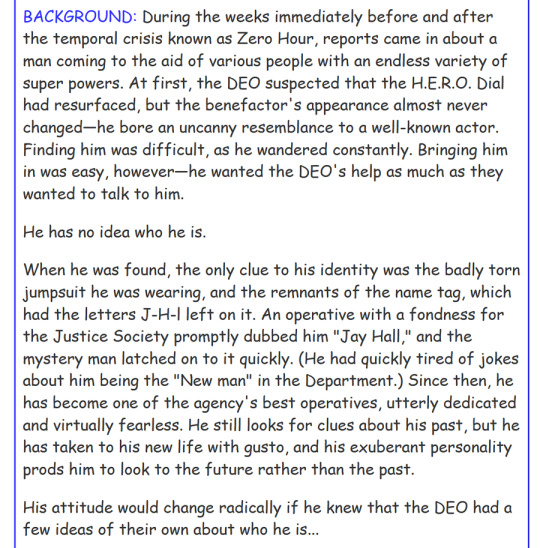
... and just in case that wasn't enough, they also just straight up confirm it in the end notes section


and just as a ridiculous little cherry on top, kyle is also here somehow

he does literally nothing but struggle in every appearance he makes




this is almost certainly just a fun little reference & not really meant to imply that this agent is actually him, but i'm choosing to ignore that because the idea of some sort of weridass mr & mrs smith situation with kyle going undercover in the DEO for completely unrelated reasons and just accidentally happening upon the truly wild conspiracy of a very not dead parallax running around as an amnesiac DEO john wick is so fucking funny. it's going to live in my head forever. everything about this is just. incredible
the writer(s) of one of the guidebook things for the dc ttrpg has parallax hal somehow having his memory completely wiped & being blasted back in time at the end of Zero Hour to the direct aftermath of coast city's destruction where he wanders around the ruins helping people with his still-very-much-intact crazy parallax godpowers until the DEO catches wind of him, tracks him down, recruits him, and turns amnesiac parallax into a top DEO agent who spends the next few years running around doing a bunch of spy shit right under all his old friends' & colleagues' noses without anyone ever noticing.... and this all happens in the random little flavor text sidebars that like 90% of people (of the 1% who will ever bother to pick the book up in the first place lol) will probably just skip over
what the fuck. this is easily top 10 the hottest concepts i've ever seen. why is it squirreled away in the most obscure possible location outside of scrawling it on a cave wall somewhere in the french countryside. i have never wanted to read a 200k+ word fic so bad in my entire life
#long post#SORRY THAT TOOK SO LONG#was not trying to keep yall in suspense like that lmfao#the pdf was fighting back#hal jordan#kyle rayner#soooo obsessed with this
240 notes
·
View notes
Text
Utena thoughtdump
Sometimes I see posts I disagree with but don’t feel like taking the time to rebut them, even indirectly, but then years later they come up in my head and I feel like writing a sort of thought dump.
THIS IS ONE OF THOSE TIMES.
So I once saw a post that was like “Utena and Ikuhara are bad because dudes get away with being manipulative and sexual, don’t get majorly punished for it, while girls who do similar things get “knocked down a peg”, using Shiori and Nanami as examples of this, vs like, Touga and co.
So like, the most obvious thing to bring up here is that one of the central themes of the show is how girls will get punished for doing stuff guys do and guys will use them as human shields and get off scot free. Anthy takes the swords in Akio’s place while he fucks around doing what he wants, that’s the major reveal. It’s fairly straightfoward as Utena metaphors go. So like...the show demonstrating this doesn’t constitute an endorsement of it, since the show pretty clearly presents that as fucked up.
I don’t think we’re meant to be HAPPY or take satisfaction in what happens to Nanami and Shiori. It is supposed to be pitiful that they get so screwed over by these dudes. who had the advantage on them from the beginning.
This take also completely ignores Kozue who actually is pretty manipulative and sexually active but isn’t ever significantly “punished” for it moreso than anyone else. I mean, she becomes a black rose duelist and is clearly pretty fucked up, but she’s not “bought low” or anything compared to anyone else. Miki is the one who gets owned more explicitly.
It also ignores that Saionji IS one of the shows biggest laughing stocks and punching bags, right up there with Nanami. Him being humiliated and punished for his actions is like. a running thing. And takes a more serious form when Touga betrays him and he’s reduced to hiding back in Wakaba’s dorm.
It’s notable Saionji is able to grab some power offered by another man and do some shitty things to get out of that situation, and hurts Wakaba to do it- and we’re pretty clearly supposed to sympathize with Wakaba here. He gets opportunities she and the other girls wouldn’t, and has no problem casting the girl who supported him aside upon getting them, and that’s not great.
IIRC, the post also went in hard on how Ruka is treated vs Shiori too, complaining about how fucked up it is he gets to “free” Juri from Shiori, claiming it’s like he “fixed” her being gay, etc.
The Ruka storyline is pretty thorny, and I can absolutely see having problems with it- it’s probably the part of Utena I have to MOST difficulty with- but we shouldn’t obscure the facts of that plot.
Ruka is treated like a martyr for helping “free” Juri from Shiori, but like, being a martyr means you die. which is a pretty big consequence.
(Also,slightly off topic, thanks to Utena being so full or weird stuff and open to interp, there’s like, a lot of ways you could take that narrative and what it’s “trying to say”. Here’s a good post on an interpretation contextualizes Ruka well for me personally- that he’s not 100% ‘real’ but a projection on Juri’s desires, something she created- It really works for me, fits perfectly into the show and irons out the parts of the that two parter that seem contradictory to the rest of the show and makes more sense on a smaller scale as well.)
But, whatever your interp of Ruka is, whether you think he’s a projection of Juri or a real boy, it’s just plain right there explicitly in the text that he doesn’t really “free” Juri from all of her feelings towards Shiori either. She explicitly says she still has them later on, just that she’s you know. moving on a bit from being eternally torturing herself over it (”I can’t set my feelings free”). The fact she says “yeah still have feelings for her” and then jokingly asks Utena for her picture because maybe she’ll put HER in a locket next is pretty explicitly the show going out of it’s way to say “she’s still gay btw just not as hung up on Shiori and willing to move on”. So any claims Ruka “fixed” Juri being gay are pretty hardcore contradicted there. Also, Juri did not leave Ohtori after the thing with Ruka, which means she still has stuff to work out, all her problems were not fixed thanks to that duel.
Shiori survives, and gets to a place where she seems more content and friendly with Juri (from that tiny snippet post-revolution) while Ruka does not, which is something to take into consideration when looking at how the show treats the two characters as well.
Moving on to Touga- he does pretty much get away with everything, but he also doesn’t get what he “wants”- Utena- despite developing apparently genuine feelings for her, because he’s still shitty and possessive towards her. His feelings for Utena are presented a bit sympathetically but...they don’t pan out, and it’s explicitly because of how badly handled the situation, challenging her to a duel and all, like she straight up tells him that.
He’s the person who’s standing there with Saionji saying “if u believe in true friendship ur a fool” near the end, and Utena being like “lol yeah im a fool.” That says something incredibly empty about Touga. He’s here still not believing people can ever genuinely have connections. He’s standing there with his “friend” basically saying “yeah i still don’t really have any genuine connections to anyone, all my friendships are still fake”. In some ways, that’s so much worse than where Shiori and Nanami ended up.
Yeah anyway so. Just a mess of thoughts there, but the tl;dr gist is: there are things you can criticize about Utena (and SO many things you can crit about Ikuhara’s other work, but I don’t think it belongs in a convo about Utena especially since he isn’t the sole creator there) and it’s wildIy open to interpretation by design, but I don’t think “it demonstrates the bad thing that the show is pretty explicitly focused on critiquing” is a really strong argument.
67 notes
·
View notes
Text
What I learned by building my own VS Code extension
VS Code is slowly closing the gap between a text editor and an interactive development environment (IDE). At the core of this extremely versatile and flexible tool lies a wonderful API that provides an extensible plugin model that is relatively easy for JavaScript developers to build on. With my first extension, VS Code All Autocomplete, reaching 25K downloads, I wanted to share what I learned from the development and maintenance of it with all of you.
Trivia! Visual Studio Code does not share any lineage with the Visual Studio IDE. Microsoft used the VS brand for their enterprise audience which has led to a lot of confusion. The application is just Code in the command line and does not work at all like Visual Studio. It takes more inspiration from TextMate and Sublime Text than Visual Studio. It shares the snippet format of TextMate (Mac only) and forgoes the XML based format used in Visual Studio.
Why you should create an extension
On the surface, VS Code does not seem to provide many reasons for why anyone would create extensions for it. The platform has most of the same features that other editors have. The snippet format is powerful, and with extensions like Settings Sync, it is easy to share them over a Gist. Code (pun intended) is open source and the team is fairly responsive to requests. Basic support can be provided without a plugin by creating a "typings" file in the npm module.
Still, creating extensions for VS Code is something all web developers should try for the following reasons:
Playing with TypeScript: Many developers are still on the edge with TypeScript. Writing an extension in VS Code gives you a chance to witness how TypeScript works in action and how much its type safety and autocomplete features can help with your next JavaScript project.
Learning: The web gets a lot of slack for its performance. VS Code demonstrates how you can develop a performance-sensitive applications in Electron and some of the techniques — the multi-process and cluster-oriented architecture is so good that all Electron apps should just steal it for their own use.
Fun: Most important, it is a lot of fun developing VS Code extensions. You can scratch an itch and end up giving back to the community and saving time for so many developers.
Trivia! Even though TypeScript is an independent programming language with many popular uses including the Angular (2+) framework, VS Code is the sister project with the most impact on the language. Being developed in TypeScript as a TypeScript editor, VS Code has a strong symbiotic relationship with TypeScript. The best way to learn the language is by looking at the source code of Visual Studio Code.
What an extension can do
VS Code exposes multiple areas where an extension can create an impact. The exposed touch points could easily fill a book. But there’s unlikely a situation where you need all of them, so I’ve put together a listing here.
These outline the various places that can be extended as of version 1.25:
Area Description Language grammar Variables, expressions, reserved words, etc. for highlighting Code Snippets Items in autocomplete with tab-based navigation to replace certain items Language configuration Auto-close and indent items like quotes, brackets, etc. Hover action item Documentation tooltip on hover Code Completion Autocomplete items when typing Error Diagnostics Squiggly red underlines to indicate potential errors Signature Helper Method signature tooltip while typing Symbol Definition Location of the code where the symbol is defined in the inline editor and go to the definition (including a ⌘+Hover tooltip) Reference For the inline editor with links, all files, and places associated with the symbol Document Highlighter List of all positions where the selected symbol exists for highlighting Symbol List of symbols navigable from the Command menu with an @ modifier Workspace Symbol Symbol provider for an entire workspace Code Action Squiggly green underline to indicate fixable errors with a fix action on click Code Lens Always present inline metadata with clickable action items Rename Support for renaming symbols used in multiple places Document Formatting Fix indentation and formatting for the entire document Document Range Formatting Fix indentation and formatting for selected text On Type Formatting Fix formatting and indentation in real time Color Provider Color popup menu alternative Configuration Defaults Override settings and save as a new set of defaults Command Commands in the ⌘+P menu Menu Menu items in the top level menu, any menus alongside the document tab bar, and context menus Key bindings Keyboard shortcuts Debugger Debugger settings for debugging a new or existing language Source Control Overrides to support a custom source control system Theme Color theme Snippet Same as code snippets above View A new section in one of the docked panels on the left View Containers A new docked panel on the left bar TypeScript server plugins Overrides for the built-in TypeScript language server Webview Alternative page in parallel to a document to show a custom rendering of a document or any custom HTML (unlike a View Container that is docked to a side) Text Decoration Decoration on the gutter of the text area Messages Popups for error, warning and informational messages on the bottom-right Quick Pick Multi-select option selector menu Input Box Text box for the user to input values Status Bar Item Icon, button, or text in the status bar Progress Show a progress indicator in the UI Tree View Create a tree like the one used to define the workspace (which can be put inside a View or a View Container) Folding Range Custom code folding into the plus button on the gutter Implementation The implementation provider (languages like and TypeScript can have declaration and implementation as separate) Diff Provider Diff view in source control mode Commit Template For commits in source control mode
Apart from this, you can invoke any functionality that the user can invoke in any of the menus with whatever parameters the user can pass. There are events on almost every functionality as well as a lot of file systems and text file-related utility methods.
Let’s start building
Alright, enough with the preamble — let’s start putting an extension together with what we’ve just learned.
Creating the extension
To build an extension, start with the VS Code extension generator.
npm install -g yo generator-code yo code
Next up, configure the options. Here’s how I set things up:

Extension Generator for VS Code
TypeScript is optional, but highly recommended. Just another way to remind you that VS Code works really well with TypeScript.
Now, you can open the folder in VS Code. I would recommend checking the initial commit. You can look at the quick start guide that gets generated in the project to understand the file structure. Take a quick stab at seeing it live. Go to the debug panel and launch the extension in debug mode. Place a breakpoint inside the activate method in extension.ts to walk through this in action. The “Hello world" application already registers a command that can launch an informational message in the footer. Go to the commands menu with ⌘+⇧+P (Ctrl+Shift+P on Windows) and select hello world.
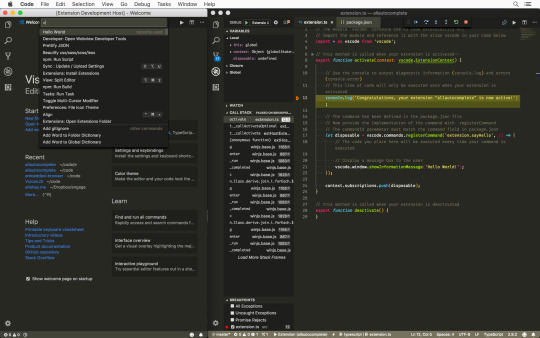
Hitting the debugger
You can put another breakpoint in the registerCommand callback to get the command event.
Open package.json for a description of the plugin’s configuration. Change activationEvents to a more specific one based on what type of language or file protocol you want to support. All Autocomplete supports all file formats, indicated by an *. You should also look at the contributes section if you want to contribute to things like settings, commands, menu items, snippets, etc.

All Autocomplete in the contributes section with contribution points
Many of these contributions have additional JSON in the same package.json file with all the information. Some APIs require code that has to be used in the activate call like vscode.commands.registerCommand for creating a command. For an autocomplete extension, the contributes section is not required and can be removed.
To use the same All Autocomplete options in extension.ts, replace the activate function with the following:
export function activate(context: vscode.ExtensionContext) { context.subscriptions.push(vscode.languages.registerCompletionItemProvider('*', { provideCompletionItems(document: vscode.TextDocument, position: vscode.Position, token: vscode.CancellationToken) { return [new vscode.CompletionItem("Hello")]; } })); }
You can specify further details about the completion item, like attached documentation using more options in the object. Now, if you debug this and type H you should see Hello in the completion menu. The code to register most of the language-based providers is nearly the same.

The All Autocomplete menu
You can see the All Autocomplete menu in vscode.languages, which provides options to register providers. Each provider has its own set of parameters that we can fill up similar to the completion item provider.

All Autocomplete with the list of language-specific providers
The document object provides access to the document with utility methods to access text at specific positions and ranges. It is strongly encouraged to use the APIs to access all documents instead of the raw Node.js APIs.
You can parse the document on demand or keep a data structure (like the trie used in All Autocomplete) optimized to search for inputs as the user is typing.
Tip: If you are looking for some text selection/manipulation APIs, there will most likely be an API already available. No need to reinvent the wheel. You can precisely get text with document.getText(document.getWordRangeAtPosition(position)). Alt+Click on any VS Code object to get to the class structure and JSDoc documentation.
Publishing the extension
Once the extension is complete, it is time to publish it to the marketplace. VS Code has a command line tool (vsce) for publishing but it does require creating an account.
Here’s how to prep the extension for submission:
Clean up the package: The package.json and README.md files provide the description and details about your extension that get displayed in the marketplace. It is essential to spruce up those files and fill all missing information so that the documentation comes out clean. Good to add some badges and a self-describing GIF to the repo.
Create an account: You need to create a Visual Studio Team Services (VSTS) account. This is the only place where VS Code ties up with Visual Studio. You need to sign up and get an access token. The VSTS interface is slightly confusing, but you don’t need to learn a new code management tool to publish. Go to the security section to get the access token. (Don’t make the same mistake as me and confuse the gear icon in the menu with security.)
Install: Use the vsce command line tool to publish extensions. It is available in npm and is extremely easy to use.

Security Settings in VSTS
Tip: The access token for VSTS expires every year and therefore the account information is extremely important. It is also required to reply to the comments on the marketplace, though most users are active on GitHub and that is where you are more likely to get bugs and feature requests.
npm install -g vsce # One time installation vsce create-publisher <name> # One time create publisher vsce login # One time login. Asks for access token. vsce publish <version> # Publish or update the extension
VS Code does not compile extensions on the server. Make sure the output folder created by compiling your extension is up to date. Also be sure to check case sensitivity of your file names because incorrect file paths will break in Linux. Native modules in Node are a huge pain and should not be used. It is impossible to compile and provide all platform variants for specific Electron versions. (Someone needs to create a PhoneGap build for npm!) This will get better over time with WebAssembly and N-API.
Support and Maintenance
The VS Code team is super active on GitHub and StackOverflow. GitHub is the right place to file bugs that you might discover in the API. The team is fairly responsive though you need to make the context extremely clear as you would with any helpful bug report.
You should have a GitHub repository for your extension and expect users to file issues directly on GitHub. Expect VS Code users to be proficient with tools and technology (some of them may have a lot more knowledge that you). Even though it’s a free endeavor, keeping humility and treating issue reporters as customers is the right behavior.
Tips on performance
VS Code has good performance because it is built with an architecture that isolates things like extensions that can cause slowness. If your extension does not return in time, your output might be ignored.
A few things that can help maintaining the performance of the editor include:
Using the official APIs: It is easy to ignore them and build your own. The "typings" file is wonderful and has documentation for all of the available APIs. A five minute search there can save a lot of time. If you need some files, it is better in most cases to request VS Code to open it in an editor than it is to read it from a disk (unless you are reading thousands of files and not leaving them open).
Expose options: Ensure there is a way for users to turn off capabilities that rely on heavy events, like every keystroke. It may not seem noticeable on your machines, but this is not the place for that. Developers maintain their dot files forever and they spend time going through options if there is an issue they to work around. There is no harm in exposing a way to gracefully degrade in case every keystroke is not possible.
Child process: Developer tools — especially on the command line — are extremely fast and well optimized. If you need something that involves a lot of files that could choke the JavaScript thread, call into a native tool and politely ask the users to install the dependency. Electron has limitations and we should accept them.
Wrapping up
VS Code is a very flexible application and provides almost all of its guts to extension developers. The workflow to develop and debug extensions is easy and every JavaScript developer should feel at home trying them out. The biggest advantage of developing extensions outside of improving our own lives is the possibility to see a huge TypeScript project in action. For that alone, I would recommend all users to definitely give it a go and share your extensions in the comments.
My extension is live on the VS Code marketplace and I would love to get your feedback on that as well. 🙂
The post What I learned by building my own VS Code extension appeared first on CSS-Tricks.
via CSS-Tricks https://ift.tt/2MAzuxw
0 notes
Text
5 Free Productivity Tools
So if you're just starting out doing freelance work and don't have a system yet, or you have a system and it doesn't work very well for you, take a look at these 5 tools that will help you be more productive, save time and manage your projects more easily.
Also for the record, I'm not getting sponsored by anyone to share these tools, this is purely to help you be more productive, and also to market myself by providing helpful information to you. =) (Now that’s what I call being transparent!)
I will be covering just the gist of what these tools are, and some of the things I really enjoyed about them, but don't just take my word for it, do some more digging for yourselves and play around with them to see if they suite you and your needs.
I've listed my favorite ones last so stick around if you want to see the best ones. Atleast in my opinion, you may find you have a better use for some, more than others.
MightyText
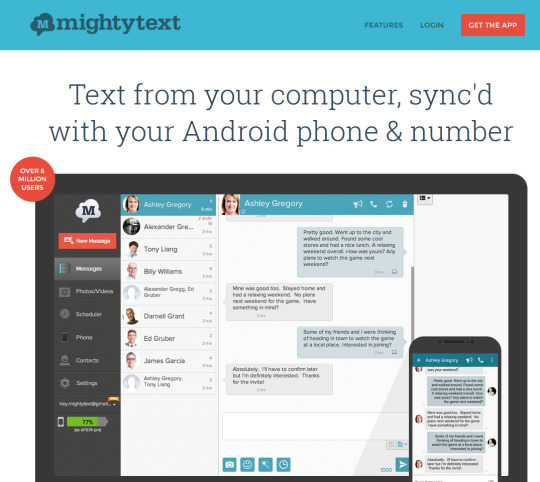
This first productivity tool syncs your smart phone messages and app notifications to your desktop. You can even set your device on the charger in another room and if you get a call, text message or an app notification (optional), you will see them pop up in the corner of your desktop screen. That way you're not playing with your phone, but are updated as needed and can choose to leave it for later, or respond immediately from you computer and get back to work!
Now you may have noticed, if you are a Windows 10 user, that the new OS has phone integration as well, so you can receive text messages to your computer and respond. That's all fine and well, however if you don't respond within the dialog box or the Action Center, you can't get back to your conversations except by looking at your phone. That's where MightyText continues to be helpful. I leave it run in minimized form until I need it, and it allows you to use the windows notifications box in place of their own.
There are a few pitfalls with it, but if you are so inclined, you can sign up for the premium version and that takes care of those issues. The main issue I've had is not having all of my contacts synced so I can't make quick new messages from my laptop. I have to first look up the contact on my phone or in Outlook to confirm the correct number to the corresponding contact, but as I mentioned before the premium version takes care of that problem because it allows for multiple contact platforms to be synced.
Toggl

What I will be discussing is the free version of Toggl, not the premium. The free version offers you the basics and will get the job done, but there's more for those who want to get all they can out of it, including Toggl business that I have not researched myself.
I use Toggl's desktop app on Windows 10 and the online reporting tools to keep track of my weekly and hourly work completion. I also use the Toggl Android app, to keep track of tasks that I do outside of the office, like reading emails while waiting for my wife in the car or working from somewhere that my laptop isn't handy. This helps me stay focused and know where I need to improve if I'm slacking off. I only track my working hours, but you can track whatever you choose. In the image below you can see an example of the desktop app.
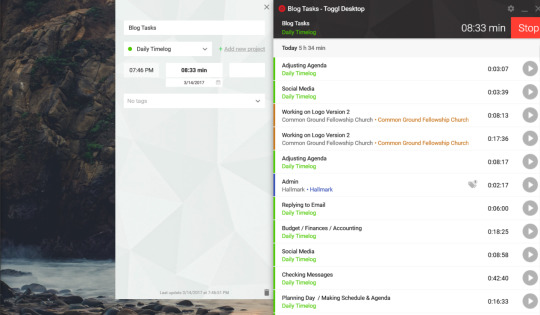
As you can see you can add tags to your entries by clicking on the entry and opening the side panel. You can also edit your entries and open up the reports page on the website where you can do a lot more, like research how long you spend on a weekly basis reading your emails or doing social media marketing. You can see an example of this in the image below.

Lastly, I would like to add that it will send you a weekly report in your email showing you where and for how long you worked on certain entries throughout the week. It's a very helpful tool, especially if you're charging by the hour for work for different clients or with a team of colleagues.
The last few images I will show you are of the mobile app, it's very helpful on the go, although sometimes it has sync errors unfortunately.
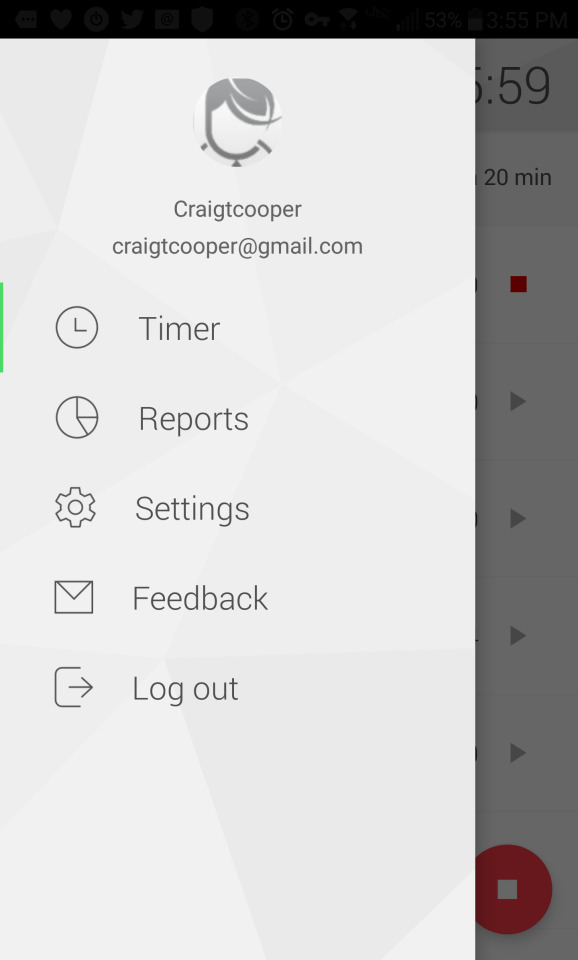
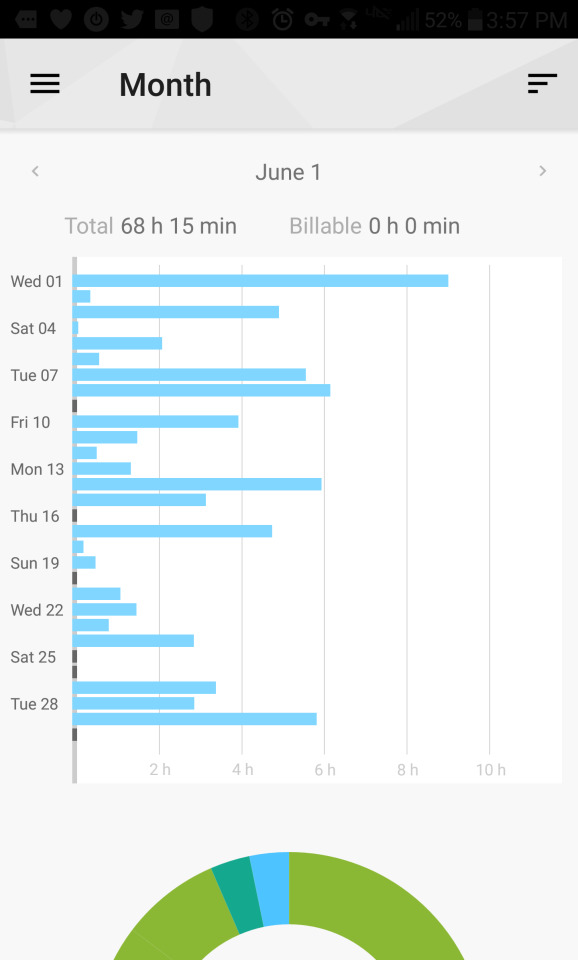
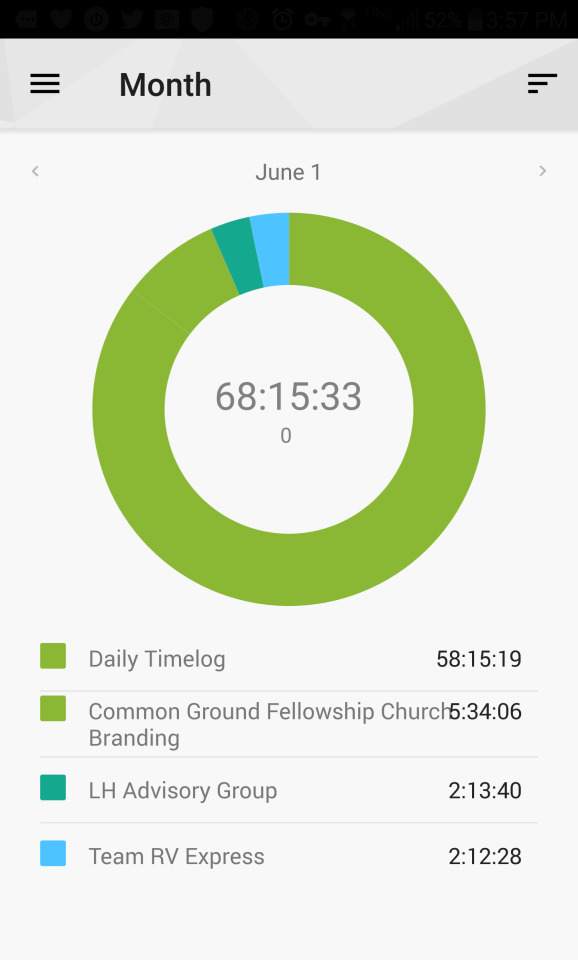
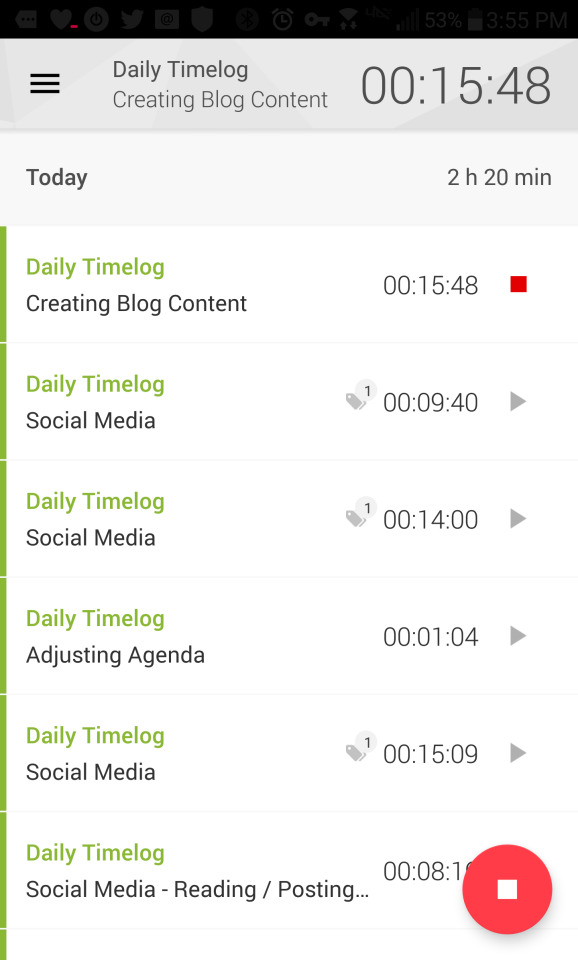
Invision App

This tool is more aimed at creatives and designers. It is an online tool that one can use to create prototypes and moodboards. It also has some other features that you can play with for yourself, I'm still learning it as I'm writing about it, but the more I use it, the more helpful I find it. If you want to go even further there is a premium service you can look into as well.
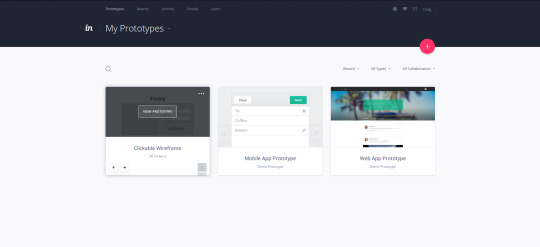
One of the things I noticed very early in my exploration is the ability to make interactive prototypes. If you have a free account and are logged in open the prototypes tab and click on the pre-made prototype titled "Web App Prototype". You will notice that within each "project" there can be multiple project cards. For this project each one of the cards are a different page to the web app. Now if you click and enter the first one on the left you will see what looks like a social media site. Remember this is just a prototype of the final version of a web app, but if you hover over the profile image on the top right hand side, a drop down will appear, additionally if you click any of the menu items there, you will be redirected to the other cards that match it's description. So you will still have to design elements in Photoshop or another application, but you can see the functionality in the InVision app, before you do a lick of coding. Pretty cool right?

Basically InVision will help get your projects organized in a presentable way to showcase to your clients or your team. On that note, it's very social, and allows for live previews to those you share to. It allows the ability to collaborate with others through comments, something they call "hotspots", where specific elements of a design can basically be highlighted and commented on and the option to designate whether a board is "On Hold", "In Progress" "Needs Review" or if a board layout has been "Approved", which seems like a very useful feature. There is also the ability to view the history of a board if you so choose, and see all the different versions of a design from start to approval.
Let's talk a little bit about InVision "Boards". I use these most frequently of the boards and prototypes options, as I like to use these to get the mood and overall feel of a project together in one area. If you are working as a team this is also a great place to share and save resources for the future, like color schemes, source imagery, typeface selection, written documents and body copy written for your project. There are so many uses for these, but you will find that out as you play with it.

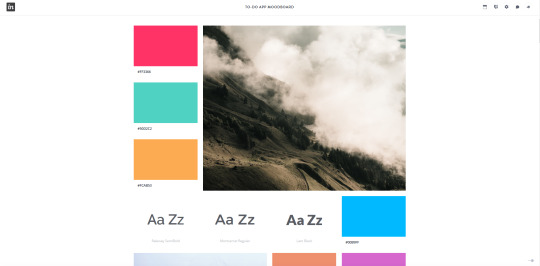
My biggest complaint about the InVision tool is that when you are working with lots of images, like one might when using the moodboards, the load time can be tediously slow. If you use lower res images that should help. Really it's the Internet's fault. Sorry Internet, we still love you!
The last helpful thing about InVision, is the InVision Blog. It always has great articles that are relevant to an aspiring designer that are not just helpful or insightful, but also help you to feel that you aren't alone and that other designers and creatives struggle with the same things you struggle with. Check it out if you have a chance!
Hootsuite

Hootsuite is a social media dashboard. Instead of posting the same article multiple times on different sites, you can link them all together and post from one place. The free version will work well for most users, but if you have a ton of social media accounts or clients you work for, it will be more beneficial to upgrade to the business platform as you are limited to a set amount of accounts that you can link. Here's the plans if you're interested!
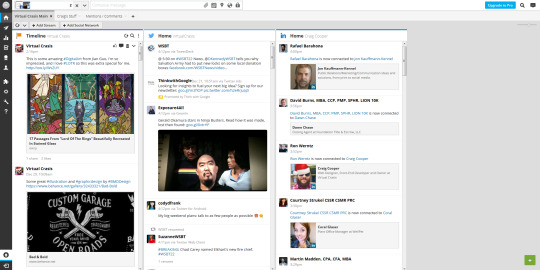
You can also check all of your feeds in one place, see your stats, make reports about your posting success and even schedule when you want to make your posts go out. For instance if you want to share a holiday post, but won't be in the office on the day you want it to go out, then just make one early and send it out at the perfect time on the special day, that way you can still enjoy it without feeling guilty about not posting something on such a crucial date for people checking their feeds!
Evernote
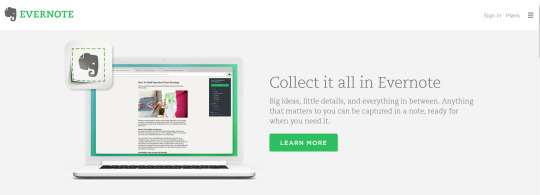
I use Evernote everyday, I only wish I had started using it earlier that's why it's my favorite and final tool I wanted to share with you! In fact I'm using it to make this post's content!
I'm using it type out the words to this post in a note within a notebook titled "Virtual Crasis Blog" and I'm collecting images inside of this note as well, that I've screen shot from my browser! (See Below)
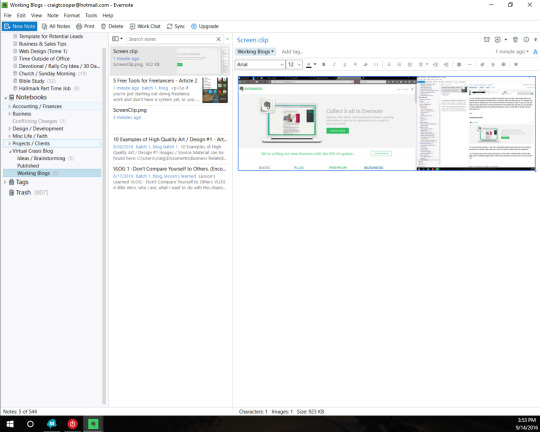
Talk about trippy 4th dimensional stuff right? Haha WRONG! It's real!
The best part is that it syncs across all of your devices, so your main workstation, to your phone, to your tablet and to anywhere you can access the Internet if you don't have your own device, just use the web application.
I use it for multiple things in my daily life. For instances, anytime I need to make a personal note I can tell my Android smartphone using Google Voice to "Note to Self" and it will ask me for the details and then save it to my Evernote. I can even make reminders that will be emailed to me when they are due.


I use Evernote for everything, from taking notes in my bible study, to keeping my daily goals and task list, to editing snippets of code and sharing it with my "work chat" colleagues who share notebooks with me! All that, and I can even remind myself that I need to check out a cool band later and get some more milk from the store! It is the single most valuable tool I use on a daily basis.
I currently am using the Plus package, which will run you $35 a year and it's totally worth it! You can also use the Free version which is ideal for testing out the features and learning how awesome it is, and then getting you hooked! They may even have a free trial for the other packages if you are a new user.
It works on Mac, it works on Windows, it works on Android and it works on everything, as far as I can tell or have seen.
In addition, Windows 10 store has the app which will make the program work more intuitively with your OS, however there are a few bugs yet, so I am still using the downloaded version from the Evernote site.
I'd also like to say again, I'm not being paid to say any of this, these are all tools I've found helpful on my journey of freelancing and being self employed, hope that you can get as much enjoyment out of them as I do!
As always, God bless and thanks for following the Virtual Crasis blog!
#ProductivityTools#WebDesign#WebDevelopment#Evernote#MightyText#Invision#Hootsuite#Toggl#Windows10#Android#MacOS#Notes#TimeTracking#SocialMedia#MoodBoarding#Prototyping#PhoneToDesktop
0 notes